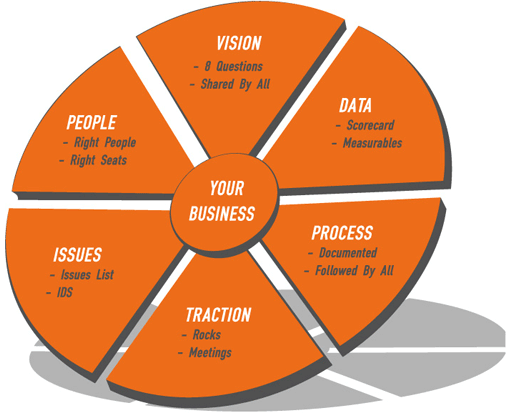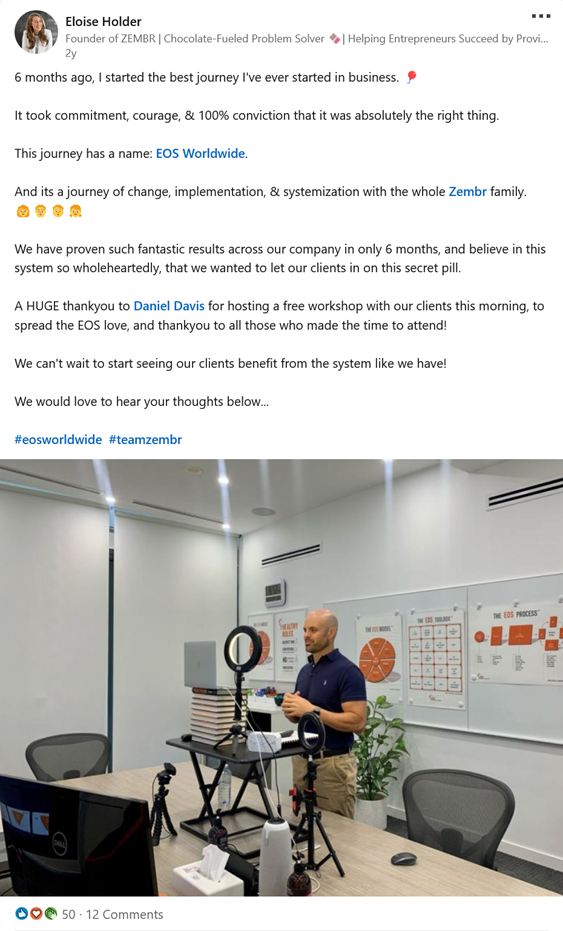Starting a business is hard. Running a business is hard. Growing a business? That’s next-level hard.
Except…
There is an easy button. A way to sort out the chaos. So instead of looking like a scene from a disaster movie, your business operates with the cool precision of a surgeon.
Friend, let us introduce you to business operating systems.
WHAT’S A BUSINESS OPERATING SYSTEM
A business operating system is a blueprint for how everything in your business runs. It describes how every role operates, how the things you do get done, and how it all fits together.
The system documents all the information that keeps your business chugging along. For a lot of companies, that information lives only in the owner’s head. Which means the owner has to be involved in EVERYTHING or risk things going off the rails.
If you’re the owner, that makes your business exhausting. And unscalable. 😫
There are a lot of ways to set up a business operating system. The Entrepreneurial Operating System (EOS), which we use at Zembr, is made of components called Vision, People, Process, Issues, Data and Traction. (More on that later.)
WHY YOU NEED A BUSINESS OPERATING SYSTEM
As organizations grow, things get complicated. You have more people doing more things – and it’s really hard to get them to do things your way.
Companies usually implement an operating system when they hit a wall. Sales are up but profits are down. Customers are complaining about a disjointed experience. Staff are unmotivated and unaccountable. Tasks go undone for weeks because everybody thought it was someone else’s job. And everyone relies so heavily on you, you’re considering putting a mattress under your desk and just living at the office.
Here’s a real story. At Zembr, we didn’t wait until we hit the proverbial wall. We implemented EOS when we were still a baby company, with only a few dozen people on staff. Our marketing manager was introduced to EOS through a previous job and fell in love with it. She convinced our founder that it was just the thing to whip Zembr into shape so we’d be ready to grow.
Want to know what happened next? Well, a lot of things. But here’s one that might get your attention – our conversion rate after implementing an operating system went from 45 to 80 percent. 🤯
THE ELEMENTS OF A BUSINESS OPERATING SYSTEM
Every system has its own trademark ways of describing its components. What you call them isn’t as important as having them all represented.
VISION
Having your vision sorted should be Priority No. 1 for every business. You need to know why your business exists and what it values. And you’re not the only one who needs to know. You have to communicate it to everyone in the organization.
You had a vision and a passion to start this company. But if your employees don’t know and share it, they simply won’t care. Their job will be just a job with no big picture meaning. Or they’ll superimpose their own values over their role, which leads to everyone pulling in a different direction.
PEOPLE
An organization is nothing without its people. When you implement a business operating system, you’ll define the roles it takes to carry out your systems and processes. And you’ll record the skills the people in those roles must have.
The reason this comes after vision is simple. It’s key to have people on your team who share your core values - there’s no point having values in place if no one is living by them.
Your business operating system helps you get the right people in the right places and give them the support they need to be rockstars.
PROCESS
How do you do what you do? Franchise businesses are really good at this. McDonald’s has a documented process for how to build a cheeseburger, when to salt the fries – probably even how to tell customers the ice cream machine is broken. So no matter which location you visit, you have a consistent experience every time.
When processes are documented and followed by all, it helps you deliver that same kind of consistency to your customers. It also improves efficiency. Chances are, you’ve already figured out the fastest, most efficient way to deliver your product or service. But if you haven’t documented that process, your employees can’t follow it. They’ll all come up with their own way of doing things. That’s either costing you in efficiency or forcing you to get involved in things way below your pay grade.
ISSUES
Every business has issues – and they’re not necessarily a bad thing.
An issue might be problem, but it might also be an opportunity. Once you identify an issue, you can discuss it, and then make a move toward solving it.
One of the key things that sets a business operating system apart is its ability to explore what might possibly change or go wrong and set up a process for what to do if it does. It empowers your team to handle recurring issues like customer complaints without bringing every little thing to your desk.
DATA
Working without KPIs is like running a race with no course markers. You can’t see the finish line. You can’t see the other racers. You have no idea if you’re ahead or behind or how close you are to finishing.
After a while, your motivation starts to fade. You slow to a jog, then to a walk. As you amble along, you try to remember what the point of this race was. Does it even matter if you win?
It’s pretty hard to stay motivated when you can’t tell how you’re doing. That’s why you might see a burst of productivity from your employees right after a performance review that fizzles out as they lose track of what progress they’ve made.
A business operating system describes how each role contributes to the big picture, and it lays out the expectations for the people in that role. Your employees can hold themselves accountable. They don’t need to wait for a performance review to see how they’re doing.
At Zembr, the bookkeeping department has a scorecard. The sales team has a scorecard. The marketing team has a scorecard. And so on down the line. Everybody has a couple of numbers that indicate their success, so every person can track their own KPIs.
For employees, this means more fulfillment and motivation to do a good job. For the business, this means more productivity. It’s a win all around.
TRACTION
In EOS, Traction is how you keep the system running. It’s built on Rocks – big goals for each person, department and the business as a whole. Your operating system helps you set these goals and establishes when and how to check in to ensure you’re making progress toward them.









